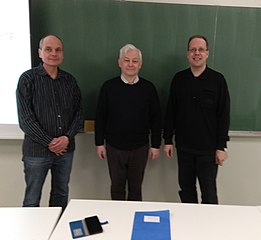Alexander was given this opportunity after winning the teacher exchange scholarship contest for visiting one of Finnish universities as a lecturer in Spring 2019.
Poincaré arrived at his geometric theorem while dealing with the three-body problem. The essence of the problem is to describe the motion of three celestial bodies moving under the influence of Newton’s law of universal gravitation.
For two of the planets, the solution is derived from known Kepler’s laws, according to one of which planets in the Solar system move in elliptical orbits, having the Sun as one of the foci.
The problem still has no full solution for three planets. The solution is of immense importance for estimating the stability of the Solar system: whether the system can survive minor perturbations. An example of such a perturbation is the situation where two largest planets of the system, Jupiter and Saturn, slightly change their orbits when passing near one another. A planet is kind of ‘dragged off’ its orbit. May this shatter the Solar system? For three planets of which one has negligible mass (restricted three-body problem), Poincaré’s genius reduced the task to a geometric problem.
Poincaré’s geometric theorem has a dramatic history.
In 1912, in the last year of his life, Henri Poincaré (1854–1912), while working on the three-body problem, published an unproved theorem (H. Poincare, Sur un theoreme de Geometrie. Rend. Circ. Mat. Palermo 33 (1912), 375–407), known as "Poincaré’s last geometric theorem".
Non-strictly speaking, the theorem asserts that every area-preserving, orientation-preserving homeomorphism of an annulus that rotates the two boundaries in opposite directions has at least two fixed points.
Poincaré proved the theorem for special cases and expressed the hope that mathematicians will find this result intriguing. So they did. This theorem is still the source of many interesting results in the theory of dynamical systems and topology. George Birkhoff was the first to respond to Poincaré’s challenge. In 1913, he published a proof of this theorem based on a witty method rather different from Poincaré’s reasoning, but the proof of the existence of the second fixed point was erroneous.
Alexander Kirillov’s lectures traced the dramatically meandering history of proving and developing Poincaré’s last geometric theorem.
Topology is not interested in object’s metrical properties. E.g., topology would not discriminate between a mug and a doughnut, since deformation converts mug’s surface into doughnut’s surface, and vice versa.
News

April 16, 2019
Professor Alexander Kirillov was invited to University of Turku to read the course for students "Poincaré’s last geometric theorem: generalizations and applications".
See also:

July 10, 2025
International School “Interaction of Hydrogen Isotopes with Structural Materials” was held at the National Center for Physics and Mathematics in Sarov, Novgorod Region. Karelian scientists gave a lecture and presentations on computational materials science – an efficient tool for rescaling test-sample experimental data to real-life power reactor structures.



